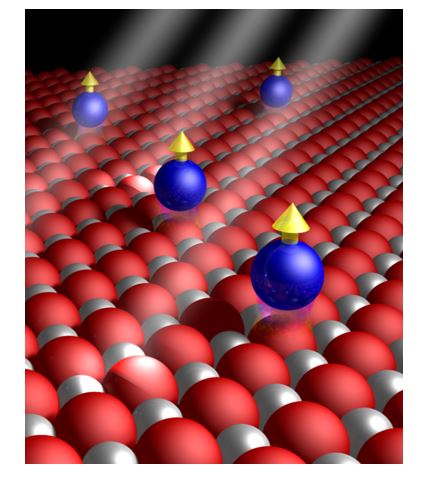Video Article Open Access
Magnetic Bits Made of Single Atoms
Luca Persichetti1,2*, F. Donati3,4,5, S. Rusponi3, S. Stepanow2, A. Singha3, R. Baltic3, K. Kummer6, C. Nistor2, P. Gambardella2, H. Brune3
1Dipartimento di Fisica,Università di Roma "Tor Vergata", Rome 00133, Italy
2Department of Materials, ETH Zurich, CH-8093, Zurich, Switzerland
31nstitute of Condensed Matter Physics, EPFL, Switzerland
4Center for Quantum Nanoscience (QNS), Institute for Basic Scierice (IBS), Seoul 03760, Republic of Korea
5Ewha Womans University, Seoul 03760, Republic of Korea
6European Synchrotron Radiation Facility, France
Vid. Proc. Adv. Mater., Volume 3, Article ID 2210378 (2022)
DOI: 10.5185/vpoam.2022.10378
Publication Date (Web): 23 Nov 2023
Copyright © IAAM
Graphical Abstract

Abstract
Magnetic storage devices such as hard drives and magnetic tapes are massively used in conventional high-capacity storage units. The increasing data-storage needs motivate the research towards novel fundamental alternatives to achieve ever-larger bit density. Individual atoms adsorbed on a surface, with each atom being able to store a single bit of data, could potentially allow maximal storage density in a solid-state system. However, in order to store and process information, it is required to stabilize the spin of the magnetic atoms against thermal and quantum fluctuations. The key to stabilize the single magnetic moment of an adatom is therefore to develop a viable route for minimizing the coupling with the surrounding electronic/crystalline environment.
In the first part of the talk, I will present the rapid evolution of this field and the sequence of advancements that led to the discovery of the first single atom magnet, namely a holmium atom on a magnesium oxide ultra-thin film. Using x-ray magnetic circular dichroism (XMCD), we found these atoms to be magnetic stable up to 40 K even in absence of an external magnetic field [1]. In addition, they can be read and written individually using a scanning tunneling microscope [2].
In the second part, I will here describe other single-atom magnets that have been investigated and the methods employed to address their magnetic properties. Over the last years, slow magnetic relaxation has been in fact observed for diverse combinations of magnetic atoms/ substrate, including 2D templates, such as graphene and transitional-metal dichalcogenides [3].
Starting from the description of the experimental results, I will present the main physical ingredients which play a role in achieving long magnetic lifetime in individual adatoms on surfaces, such as phonon bottleneck and weak coupling to the electronic and vibrational degrees of freedom of the substrate [4,5].
Finally, I will discuss the limitations of the present systems and techniques and identify the challenges to close the gap toward potential future technological applications.
Keywords
Single-atom magnets 1; nanomagnetism2; spin 3.
Acknowledgement
I acknowledge the support from Lazio Innova (Regione Lazio, Italy) through the project “Gruppi di ricerca 2020” A0375-2020-36566.
References
- M. Liu, C. J. Castilho, R. H. Hurt, Advanced Materials Letters, 2018, 9, 843. F. Donati, S. Rusponi, S. Stepanow, C. Wäckerlin, A. Singha, L. Persichetti, R. Baltic, K. Diller, F. Patthey, E. Fernandes, J. Dreiser, Ž. Šljivančanin, K. Kummer, C. Nistor, P. Gambardella, H. Brune, Science, 2016 352 318.y
- F.D. Natterer, K. Yang, W. Paul, P. Willke, T. Choi, T. Greber, A.J. Heinrich, C.P. Lutz, Nature, 2017 543 226.
- V. Bellini, S. Rusponi, J. Kolorenč, S.K. Mahatha, M.A. Valbuena, L. Persichetti, M. Pivetta, B.V. Sorokin, D. Merk, S. Reynaud, D. Sblendorio, S. Stepanow, C. Nistor, P. Gargiani, D. Betto, A. Mugarza, P. Gambardella, H. Brune, C. Carbone, A. Barla, ACS Nano, 2022 16 11182.
- F. Donati, S. Rusponi, S. Stepanow, L. Persichetti, A. Singha, D.M. Juraschek, C. Wäckerlin, R. Baltic, M. Pivetta, K. Diller, C. Nistor, J. Dreiser, K. Kummer, E. Velez-Fort, N.A. Spaldin, H. Brune, P. Gambardella, Phys. Rev. Lett., 2020 124 077204.
- F. Donati, M. Pivetta, C. Wolf, A. Singha, C. Wäckerlin, R. Baltic, E. Fernandes, J.-G. de Groot, S.L. Ahmed, L. Persichetti, C. Nistor, J. Dreiser, A. Barla, P. Gambardella, H. Brune, S. Rusponi, Nano Lett., 2021 21 8266.
Biography
I have a Master in Material Science and Technology and a PhD in Physics obtained from the University of Roma “Tor Vergata” in November 2012. Since my PhD, my research activity has been focused on the investigation of surface systems/phenomena in ultra-high vacuum conditions using microscopy and spectroscopy techniques, in particular scanning probe microscopies and X-ray absorption and photoelectron spectroscopies. In 2013, I was awarded a highly competitive postdoctoral fellowship funded by the Swiss Federal Institute of Technology ETH-Zurich and the Marie Curie Actions to explore single-atom systems for applications in computation and data-storage with the aim to demonstrate the use of individual magnetic atoms on surfaces as qubits. This work demonstrated, for the first time, that individual rare-earth atoms on ultra-thin insulating layers grown on non-magnetic metal substrates exhibit magnetic remanence and, therefore, are the first magnets formed by a single surface-adsorbed atom (Science 352, 318). My research activity on single-atom magnets has continued since then and has been carried out in collaboration with international partners at ETH and the École Polytechnique Fédérale de Lausanne (EPFL), through the competitive access to different synchrotron radiation facilities across Europe and by exploiting spin polarized scanning tunneling microscopy (STM) and Electrons Spin Resonance (ESR) STM (I was involved in the development of one of the first ESR-STM in the world). I have been back in Italy since 2018, first at the Department of Sciences at Roma Tre University as non-tenured assistant professor (RTDA) and now at the Department of Physics of “Tor Vergata” University as tenure-track assistant professor (RTDB).
Video Proceedings of Advanced Materials

Upcoming Congress



